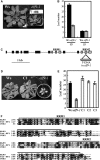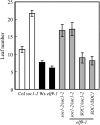The RNA binding protein ELF9 directly reduces SUPPRESSOR OF OVEREXPRESSION OF CO1 transcript levels in arabidopsis, possibly via nonsense-mediated mRNA decay
- PMID: 19376936
- PMCID: PMC2685614
- DOI: 10.1105/tpc.108.064774
The RNA binding protein ELF9 directly reduces SUPPRESSOR OF OVEREXPRESSION OF CO1 transcript levels in arabidopsis, possibly via nonsense-mediated mRNA decay
Abstract
SUPPRESSOR OF OVEREXPRESSION OF CO1 (SOC1) is regulated by a complex transcriptional regulatory network that allows for the integration of multiple floral regulatory inputs from photoperiods, gibberellin, and FLOWERING LOCUS C. However, the posttranscriptional regulation of SOC1 has not been explored. Here, we report that EARLY FLOWERING9 (ELF9), an Arabidopsis thaliana RNA binding protein, directly targets the SOC1 transcript and reduces SOC1 mRNA levels, possibly through a nonsense-mediated mRNA decay (NMD) mechanism, which leads to the degradation of abnormal transcripts with premature translation termination codons (PTCs). The fully spliced SOC1 transcript is upregulated in elf9 mutants as well as in mutants of NMD core components. Furthermore, a partially spliced SOC1 transcript containing a PTC is upregulated more significantly than the fully spliced transcript in elf9 in an ecotype-dependent manner. A Myc-tagged ELF9 protein (MycELF9) directly binds to the partially spliced SOC1 transcript. Previously known NMD target transcripts of Arabidopsis are also upregulated in elf9 and recognized directly by MycELF9. SOC1 transcript levels are also increased by the inhibition of translational activity of the ribosome. Thus, the SOC1 transcript is one of the direct targets of ELF9, which appears to be involved in NMD-dependent mRNA quality control in Arabidopsis.
Figures








Similar articles
-
Bruno-like proteins modulate flowering time via 3' UTR-dependent decay of SOC1 mRNA.New Phytol. 2013 May;198(3):747-756. doi: 10.1111/nph.12181. Epub 2013 Feb 25. New Phytol. 2013. PMID: 23437850
-
The SOC1-SPL module integrates photoperiod and gibberellic acid signals to control flowering time in Arabidopsis.Plant J. 2012 Feb;69(4):577-88. doi: 10.1111/j.1365-313X.2011.04813.x. Epub 2011 Nov 16. Plant J. 2012. PMID: 21988498
-
Crosstalk between cold response and flowering in Arabidopsis is mediated through the flowering-time gene SOC1 and its upstream negative regulator FLC.Plant Cell. 2009 Oct;21(10):3185-97. doi: 10.1105/tpc.108.063883. Epub 2009 Oct 13. Plant Cell. 2009. PMID: 19825833 Free PMC article.
-
Consequences for Pancreatic β-Cell Identity and Function of Unregulated Transcript Processing.Front Endocrinol (Lausanne). 2021 Mar 8;12:625235. doi: 10.3389/fendo.2021.625235. eCollection 2021. Front Endocrinol (Lausanne). 2021. PMID: 33763030 Free PMC article. Review.
-
Pumilio Puf domain RNA-binding proteins in Arabidopsis.Plant Signal Behav. 2011 Mar;6(3):364-8. doi: 10.4161/psb.6.3.14380. Epub 2011 Mar 1. Plant Signal Behav. 2011. PMID: 21350339 Free PMC article. Review.
Cited by
-
Major transcriptomic differences are induced by warmer temperature conditions experienced during asexual and sexual reproduction in Fragaria vesca ecotypes.Front Plant Sci. 2023 Jul 14;14:1213311. doi: 10.3389/fpls.2023.1213311. eCollection 2023. Front Plant Sci. 2023. PMID: 37521931 Free PMC article.
-
Genome-Wide Identification of the Early Flowering 4 (ELF4) Gene Family in Cotton and Silent GhELF4-1 and GhEFL3-6 Decreased Cotton Stress Resistance.Front Genet. 2021 Jul 6;12:686852. doi: 10.3389/fgene.2021.686852. eCollection 2021. Front Genet. 2021. PMID: 34326861 Free PMC article.
-
Ancient allopolyploidy and specific subgenomic evolution drove the radiation of poplars and willows.Nat Commun. 2025 Jul 25;16(1):6881. doi: 10.1038/s41467-025-62178-y. Nat Commun. 2025. PMID: 40715060 Free PMC article.
-
The spliceosome-activating complex: molecular mechanisms underlying the function of a pleiotropic regulator.Front Plant Sci. 2012 Jan 26;3:9. doi: 10.3389/fpls.2012.00009. eCollection 2012. Front Plant Sci. 2012. PMID: 22639636 Free PMC article.
-
Possible Role of MADS AFFECTING FLOWERING 3 and B-BOX DOMAIN PROTEIN 19 in Flowering Time Regulation of Arabidopsis Mutants with Defects in Nonsense-Mediated mRNA Decay.Front Plant Sci. 2017 Feb 14;8:191. doi: 10.3389/fpls.2017.00191. eCollection 2017. Front Plant Sci. 2017. PMID: 28261246 Free PMC article.
References
-
- Abe, M., Kobayashi, Y., Yamamoto, S., Daimon, Y., Yamaguchi, A., Ikeda, Y., Ichinoki, H., Notaguchi, M., Goto, K., and Araki, T. (2005). FD, a bZIP protein mediating signals from the floral pathway integrator FT at the shoot apex. Science 309 1052–1056. - PubMed
-
- Arciga-Reyes, L., Wootton, L., Kieffer, M., and Davies, B. (2006). UPF1 is required for nonsense-mediated mRNA decay (NMD) and RNAi in Arabidopsis. Plant J. 47 480–489. - PubMed
-
- Ausin, I., Alonso-Blanco, C., Jarillo, J.A., Ruiz-Garcia, L., and Martinez-Zapater, J.M. (2004). Regulation of flowering time by FVE, a retinoblastoma-associated protein. Nat. Genet. 36 162–166. - PubMed
-
- Bäurle, I., and Dean, C. (2006). The timing of developmental transitions in plants. Cell 125 655–664. - PubMed
-
- Bezerra, I.C., Michaels, S.D., Schomburg, F.M., and Amasino, R.M. (2004). Lesions in the mRNA cap-binding gene ABA HYPERSENSITIVE 1 suppress FRIGIDA-mediated delayed flowering in Arabidopsis. Plant J. 40 112–119. - PubMed
Publication types
MeSH terms
Substances
Grants and funding
LinkOut - more resources
Full Text Sources
Other Literature Sources
Molecular Biology Databases
Research Materials

